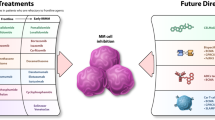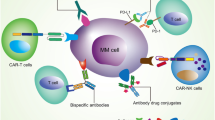Abstract
Multiple myeloma (MM)—a malignancy of the bone marrow—remains incurable by current therapies, and there is an urgent need for new drugs based on a better understanding of the underlying disease biology. MM is characterized by monoclonal plasma cells that accumulate in the bone marrow, which provides a microenvironment that promotes tumor cell growth and survival and protection against various therapeutic agents. The MM cell interacts with bone marrow stromal cells and endothelial cells, as well as osteoblasts and osteoclasts. Our understanding of the tumor microenvironment has already prompted the development of new agents that are aimed at disrupting the multiple facets of these interactions. It has also enabled the development of a comprehensive and rational approach to preclinical evaluation of new agents, facilitating the translation of in vitro studies to in vivo tumor models and, subsequently, to clinical trials. In this review, we describe the preclinical studies that led to the development of clinical trials of thalidomide and its immunomodulatory derivatives as therapeutic agents for MM. These drugs, alone or in combination, have shown impressive activity at all stages of the disease, and these demonstrations of clinical benefit have in turn validated our model systems for drug discovery in MM. Integration of data from clinical trials and laboratory studies will allow the design of future clinical trials that combine thalidomide and its derivatives with other drugs, ultimately leading to more effective therapies and better outcomes in patients with MM.
This is a preview of subscription content, access via your institution
Access options
Subscribe to this journal
Receive 12 print issues and online access
$209.00 per year
only $17.42 per issue
Buy this article
- Purchase on Springer Link
- Instant access to full article PDF
Prices may be subject to local taxes which are calculated during checkout


Similar content being viewed by others
References
Jemal A et al. (2005) Cancer statistics, 2005. CA Cancer J Clin 55: 10–30
Attal M and Harousseau JL (1999) Autologous peripheral blood progenitor cell transplantation for multiple myeloma. Baillieres Best Pract Res Clin Haematol 12: 171–191
Anderson KC (2003) Moving disease biology from the lab to the clinic. Cancer 97: 796–801
Hideshima T et al. (2000) Thalidomide and its analogs overcome drug resistance of human multiple myeloma cells to conventional therapy. Blood 96: 2943–2950
Richardson PG et al. (2002) Immunomodulatory drug CC-5013 overcomes drug resistance and is well tolerated in patients with relapsed multiple myeloma. Blood 100: 3063–3067
Hideshima T et al. (2004) Advances in biology of multiple myeloma: clinical applications. Blood 104: 607–618
Hideshima T et al. (2002) The biological sequelae of stromal cell-derived factor-1alpha in multiple myeloma. Mol Cancer Ther 1: 539–544
Asosingh K (2003) Migration, adhesion and differentiation of malignant plasma cells in the 5T murine model of myeloma. Verh K Acad Geneeskd Belg 65: 127–134
Uchiyama H et al. (1992) Characterization of adhesion molecules on human myeloma cell lines. Blood 80: 2306–2314
Abe M et al. (2004) Osteoclasts enhance myeloma cell growth and survival via cell–cell contact: a vicious cycle between bone destruction and myeloma expansion. Blood 104: 2484–2491
Kumar S et al. (2004) Endothelial cells induce multiple myeloma cell proliferation protect against conventional and novel therapies [abstract]. Blood 104: a2354
Chauhan D et al. (1996) Multiple myeloma cell adhesion-induced interleukin-6 expression in bone marrow stromal cells involves activation of NF-kappa B. Blood 87: 1104–1112
Tai YT et al. (2003) Insulin-like growth factor-1 induces adhesion and migration in human multiple myeloma cells via activation of beta1-integrin and phosphatidylinositol 3′-kinase/AKT signaling. Cancer Res 63: 5850–5858
Podar K and Anderson KC (2005) The pathophysiologic role of VEGF in hematologic malignancies: therapeutic implications. Blood 105: 1383–1395
Gupta D et al. (2001) Adherence of multiple myeloma cells to bone marrow stromal cells upregulates vascular endothelial growth factor secretion: therapeutic applications. Leukemia 15: 1950–1961
Podar K et al. (2001) Vascular endothelial growth factor triggers signaling cascades mediating multiple myeloma cell growth and migration. Blood 98: 428–435
Rajkumar SV et al. (2002) Bone marrow angiogenesis in 400 patients with monoclonal gammopathy of undetermined significance, multiple myeloma, and primary amyloidosis. Clin Cancer Res 8: 2210–2216
Kumar S et al. (2004) Effect of thalidomide therapy on bone marrow angiogenesis in multiple myeloma. Leukemia 18: 624–627
Kumar S et al. (2004) Bone marrow angiogenic ability and expression of angiogenic cytokines in myeloma: evidence favoring loss of marrow angiogenesis inhibitory activity with disease progression. Blood 104: 1159–1165
Damiano JS et al. (1999) Cell adhesion mediated drug resistance (CAM-DR): role of integrins and resistance to apoptosis in human myeloma cell lines. Blood 93: 1658–1667
Roodman GD (2004) Pathogenesis of myeloma bone disease. Blood Cells Mol Dis 32: 290–292
Urashima M et al. (1997) The development of a model for the homing of multiple myeloma cells to human bone marrow. Blood 90: 754–765
Mitsiades CS et al. (2003) Fluorescence imaging of multiple myeloma cells in a clinically relevant SCID/NOD in vivo model: biologic and clinical implications. Cancer Res 63: 6689–6696
Singhal S et al. (1999) Antitumor activity of thalidomide in refractory multiple myeloma. N Engl J Med 341: 1565–1571
Eriksson T et al. (2001) Clinical pharmacology of thalidomide. Eur J Clin Pharmacol 57: 365–376
Aweeka F et al. (2001) Pharmacokinetics and pharmacodynamics of thalidomide in HIV patients treated for oral aphthous ulcers: ACTG protocol 251. AIDS Clinical Trials Group. J Clin Pharmacol 41: 1091–1097
Mitsiades N et al. (2002) Apoptotic signaling induced by immunomodulatory thalidomide analogs in human multiple myeloma cells: therapeutic implications. Blood 99: 4525–4530
Chauhan D et al. (1997) Dexamethasone induces apoptosis of multiple myeloma cells in a JNK/SAP kinase independent mechanism. Oncogene 15: 837–843
Lentzsch S et al. (2003) Immunomodulatory analogs of thalidomide inhibit growth of Hs Sultan cells and angiogenesis in vivo. Leukemia 17: 41–44
Haslett PA (1998) Anticytokine approaches to the treatment of anorexia and cachexia. Semin Oncol 25: 53–57
LeBlanc R et al. (2004) Immunomodulatory drug costimulates T cells via the B7-CD28 pathway. Blood 103: 1787–1790
McHugh SM et al. (1995) The immunosuppressive drug thalidomide induces T helper cell type 2 (Th2) and concomitantly inhibits Th1 cytokine production in mitogen- and antigen-stimulated human peripheral blood mononuclear cell cultures. Clin Exp Immunol 99: 160–167
Davies FE et al. (2001) Thalidomide and immunomodulatory derivatives augment natural killer cell cytotoxicity in multiple myeloma. Blood 98: 210–216
Barlogie B et al. (2000) Long term follow up of 169 patients receiving a phase II trial of single agent thalidomide for advanced and refractory multiple myeloma (MM) [abstract]. Blood 96: a2213
Grosbois B et al. (2001) Thalidomide (Thal) in the Treatment of advanced multiple myeloma (MM). A prospective study of 120 patients [abstract]. Blood 98: a689
Kumar S et al. (2003) Response rate, durability of response, and survival after thalidomide therapy for relapsed multiple myeloma. Mayo Clin Proc 78: 34–39
Schey SA et al. (2004) Phase I study of an immunomodulatory thalidomide analog, CC-4047, in relapsed or refractory multiple myeloma. J Clin Oncol 22: 3269–3276
Tricot G et al. (2001) Angiochemotherapy (ACT) for multiple myeloma (MM) with DT-PACE results in a high response rate, but in contrast to tandem transplants with melphalan does not affect durable disease control [abstract]. Blood 98: a3531
Weber D et al. (2003) Thalidomide alone or with dexamethasone for previously untreated multiple myeloma. J Clin Oncol 21: 16–19
Rajkumar SV et al. (2002) Combination therapy with thalidomide plus dexamethasone for newly diagnosed myeloma. J Clin Oncol 20: 4319–4323
Rajkumar SV et al. (2004) Thalidomide plus dexamethasone versus dexamethasone alone in newly diagnosed multiple myeloma (E1A00): results of a phase III trial coordinated by the Eastern Cooperative Oncology Group [abstract]. Blood 104: a205
Stewart KA et al. (2004) Results of a multi-center randomized phase II trial of thalidomide and prednisone maintenance therapy for multiple myeloma following autologous stem cell transplant [abstract]. Blood 104: a335
Attal M et al. (2004) Maintenance treatment with thalidomide after autologous transplantation for myeloma: first analysis of a prospective randomized study of the Intergroupe Francophone du Myelome (IFM 99 02) [abstract]. Blood 104: a535
Alexanian R et al. (2003) Thalidomide with or without dexamethasone for refractory or relapsing multiple myeloma. Ann Oncol 13: 1116–1119
Fahdi IE et al. (2004) Bradycardia during therapy for multiple myeloma with thalidomide. Am J Cardiol 93: 1052–1055
Tosi P et al. (2002) Salvage therapy with thalidomide in patients with advanced relapsed/refractory multiple myeloma. Haematologica 87: 408–414
Schey SA et al. (2003) An UK myeloma forum phase II study of thalidomide; long term follow-up and recommendations for treatment. Leuk Res 27: 909–914
Hus M et al. (2001) Thalidomide treatment of resistant or relapsed multiple myeloma patients. Haematologica 86: 404–408
Durie BG (2002) Low-dose thalidomide in myeloma: efficacy and biologic significance. Semin Oncol 29: 34–38
Rajkumar SV et al. (2003) Thalidomide as initial therapy for early-stage myeloma. Leukemia 17: 775–779
Juliusson G et al. (2000) Frequent good partial remissions from thalidomide including best response ever in patients with advanced refractory and relapsed myeloma. Br J Haematol 109: 89–96
Garcia-Sanz R et al. (2004) The oral combination of thalidomide, cyclophosphamide and dexamethasone (ThaCyDex) is effective in relapsed/refractory multiple myeloma. Leukemia 18: 856–863
Kropff MH et al. (2003) Hyperfractionated cyclophosphamide in combination with pulsed dexamethasone and thalidomide (HyperCDT) in primary refractory or relapsed multiple myeloma. Br J Haematol 122: 607–616
Offidani M et al. (2004) Thalidomide plus oral melphalan compared with thalidomide alone for advanced multiple myeloma. Hematol J 5: 312–317
Dimopoulos MA et al. (2004) Primary treatment with pulsed melphalan, dexamethasone, thalidomide (MDT) for symptomatic patients with multiple myeloma ≥ 75 years of age [abstract]. Blood 104: a1482
Palumbo A et al. (2004) A prospective randomized trial of oral melphalan, prednisone, thalidomide (MPT) vs oral melphalan, prednisone (MP): an interim analysis [abstract]. Blood 104: a207
Zangari M et al. (2004) Marked activity of velcade plus thalidomide (V+T) in advanced and refractory multiple myeloma (MM) [abstract]. Blood 104: a1480
Alexanian R et al. (2004) VTD (velcade, thalidomide, dexamethasone) as primary therapy for newly-diagnosed multiple myeloma [abstract]. Blood 104: a210
Author information
Authors and Affiliations
Corresponding author
Ethics declarations
Competing interests
KC Anderson declared competing interests. He receives research support from Celgene, Novartis and Millennium.
Glossary
- POST-GERMINAL-CENTER B CELLS
-
The centrocytes that survive in the germinal center and mature into enduring class-switched plasma cells or memory B cells
- STROMAL CELLS
-
Connective tissue cells of an organ found in the loose connective tissue; usually associated with the uterine mucosa, ovary, and hematopoietic system
- OSTEOBLASTS
-
Cells that arise from fibroblasts and which, as they mature, are associated with the production of bone
- OSTEOCLASTS
-
Large multinuclear cells associated with the absorption and removal of bone
- SEVERE COMBINED IMMUNODEFICIENT (SCID) MICE
-
Mice homozygous for the mutant autosomal recessive gene scid; these mice lack mature, functional lymphocytes and are susceptible to lethal opportunistic infections
- ERYTHEMA NODOSUM LEPROSUM
-
An acute type of lepromatous reaction displaying tender deep cutaneous and subcutaneous nodules of the face, thighs, and arms
- ENANTIOMERS
-
A pair of chiral isomers (stereoisomers) that are direct, non-superimposable mirror images of each other
- TANDEM TRANSPLANTS
-
Surgical procedures to collect sufficient stem cells to perform two consecutive transplants each preceded by a course of high-dose chemotherapy
- SMOLDERING/INDOLENT MM
-
Asymptomatic myeloma; patients are usually observed without treatment until evidence of disease progression
Rights and permissions
About this article
Cite this article
Kumar, S., Anderson, K. Drug Insight: thalidomide as a treatment for multiple myeloma. Nat Rev Clin Oncol 2, 262–270 (2005). https://doi.org/10.1038/ncponc0174
Received:
Accepted:
Issue Date:
DOI: https://doi.org/10.1038/ncponc0174
This article is cited by
-
Thalidomide for prostate cancer: is there progress?
Nature Reviews Urology (2009)
-
Does the addition of thalidomide to MP or low-intensity SCT improve survival in elderly multiple myeloma patients?
Nature Clinical Practice Oncology (2008)
-
Initial Therapy of Multiple Myeloma in Patients who are Candidates for Stem Cell Transplantation
Current Treatment Options in Oncology (2007)
-
The current status of reduced-intensity allogeneic hematopoietic stem cell transplantation for multiple myeloma
Leukemia (2006)



